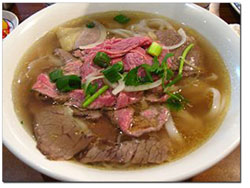|
| ||
| The pho must go on
by Ari LeVaux Pho, a brothy soup of rice noodles and beef, was created about 100 years ago in northern Vietnam. It’s pronounced like “fur” without the “r,” though it’s often mistakenly called “faux.” The word “pho” is probably a twist on the French feu, meaning fire—as in Pot-au-feu, or “pot on the fire,” a soup that influenced pho during France’s colonization of Vietnam. While commonly described on English-language menus as “Vietnamese beef noodle soup,” it’s appropriate that “fire” is the more literal translation for this unique brand of wet heat. I first fell for pho one hot night in Bangkok, in an alley where several food carts were serving nothing but Thai-style pho, aka guoi tiao, or “noodle soup.” Charmed by the fragrant smell, I took a seat on a folding chair. A vendor called out to me. I nodded. She delivered a caddy of sauces to my table, and a plate piled with bean sprouts, chili peppers, basil, cilantro, mint, green onions and a lime wedge. This side salad represents an evolution of traditional pho that began in Hanoi, where pho was transplanted by northern hill folk fleeing southward, away from the communists. Although some northern Vietnamese purists consider the salad-in-your-soup thing something of a pho-paux, if you will, I think that adding a plate full of fragrant herbs and crunchy sprouts to your steaming bowl is a spectacular development. The vendor placed a huge bowl before me, and its contents steamed my face as I stripped the leaves from their stalks and dropped them into the bowl along with bean sprouts, a squeeze of lime, and a splashing of the sauces at my disposal, which were hot, sour, sweet, spicy and fishy in flavor. As I slurped through that soup, I became aware that the back of my neck was cool, thanks to the evaporation of the sweat that had gathered there. When my pho was gone, I noticed that my nose was running and my shirt was drenched. The hot soup had heated and hydrated my body, while the chili opened my arteries and got the adrenaline flowing, giving me a refreshing, cleansing sweat. Thanks to the way it cooled me down that hot night, to this day pho remains one of my secret weapons of summertime, alongside cold soups like gazpacho and vichyssoise. Since its invention in northern Vietnam and tweaking elsewhere in Southeast Asia, pho has had a restless career, migrating to the far corners of the globe and welcoming local ingredients wherever it lands. In the United States there are chains of Vietnamese beef noodle soup restaurants, including “Pho King,” “Pho 2000,” and my favorite, “What the Pho?” These places generally have large menus featuring many pho variations including beef tendon, or slices of raw, tender beef that cook in your bowl at the table. There’s also chicken, seafood, pork and vegetarian pho. In addition to the cleansing hot flashes, another reason summer is pho season is the bounty of veggie options with which to liven up your bowl, especially if you make your pho from scratch. Here’s a basic recipe for a traditional pho of beef flank (or some other tough cut). Those who want alternate meats or vegetarian options can modify accordingly. Parboil some beef bones for 10 minutes to release the particles, then dump that water and put the bones in 6 quarts clean water (this step will keep your broth delicate and clear). Bring the pot to a boil and then simmer with 8 star anise pods (either whole or in pieces), 1 tablespoon cardamom pods, a 3-inch cinnamon stick, six cloves, 4 tablespoons fish sauce, 1 tablespoon salt, a ½ cup sugar, and 1 pound tough red meat, cut into 2-inch chunks. Andrea Nguyen, who’s written extensively about pho for the San Jose Mercury News (and whose mother is from North Vietnam) insists on the importance of adding char-roasted onions and ginger to the broth. To do this, slowly cook 2 medium yellow onions and a 4-inch piece of ginger over an open flame until lightly burned—charred, blistered and fragrant. Allow these to cool, remove the blackened parts under the faucet, or with a knife, and add whole to the broth. When the meat is falling-apart tender, remove it. The stock should simmer for three hours total. Close to serving time, blanch some rice noodles (for 10–20 seconds) in boiling water. Rinse the noodles to remove starch, drain, and set aside. The noodles should be just a little soft, but still al-dente enough to send you to el dentist (the noodles will finish cooking when the broth is added). Meanwhile, assemble your side salads with bean sprouts, chopped scallions, sliced or crushed chili peppers, leafy herbs of your choice, and lime wedges. Make sure your condiments are in place, including hoisin sauce and red chili sauce – such as the ubiquitous Sriracha, in the squeeze bottle with the rooster on it. These condiments found their pho niche in Hanoi, along with the side salad. Some people like to dip hot chili peppers in their pho and add heat that way – heat being essential to the full-on hot-flash experience. I’ve been known to add mayo, which makes pretty much anything taste better. Place some noodles in the bowls, but not too many, as they will absorb broth; about a third of a bowl of noodles is a good rule of thumb. Place cooked meat atop the noodles, along with fresh, seasonal, raw veggies, like thin-sliced carrots, peas, onions or broccoli. Ladle broth into the bowls and serve. You should have a handkerchief – or plenty of napkins – on hand as you as you sip and sweat your way through this meal you won’t quickly pho-get. •
|


